Budgies, also known as parakeets, are popular and beloved pet birds known for their vibrant colors and cheerful personalities. However, like any living creature, budgies can develop health issues that require attention and care.
One common problem experienced by budgies is an overgrown beak. In this article, we will explore budgie beak overgrown – causes and treatments.
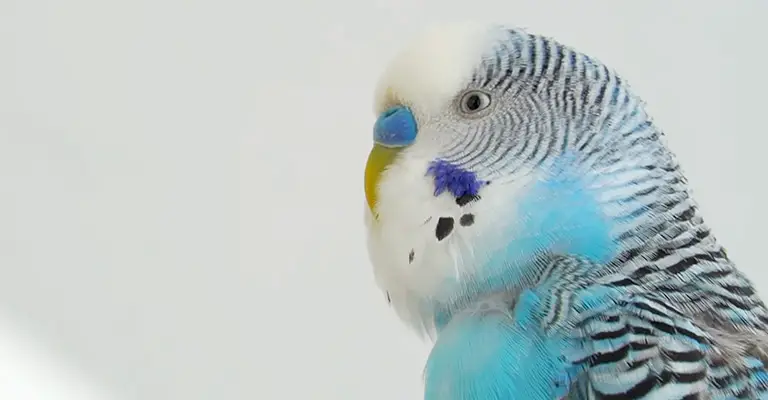
Budgie Beak Overgrown: Causes and Treatment
Below are the causes why your budgie might have an overgrown beak and some easy ways to treat it:
Causes of Budgie Beak Overgrowth
Below are the reasons why the beak of a budgie grows fast:
Nutritional Imbalance
Budgies require a balanced diet consisting of seeds, fresh fruits, vegetables, and pellets. Inadequate nutrition can lead to improper beak growth. A lack of vitamin A, calcium, or other essential nutrients can weaken the beak structure, causing it to grow excessively.
Lack of Proper Chew Toys
Budgies love to chew and nibble on objects to keep their beaks in good shape. Insufficient access to appropriate chew toys and perches can result in abnormal beak growth. Regular chewing helps wear down the beak naturally.
Beak Injuries
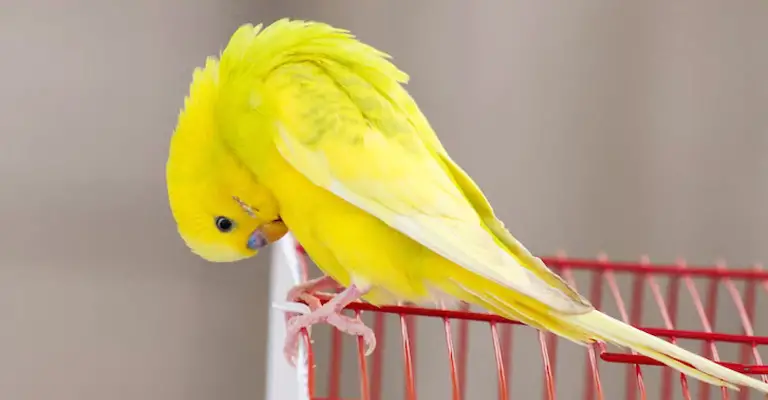
Trauma to the beak, such as a fracture or damage, can disrupt its normal growth. Injuries can be caused by accidents, fights with cage mates, or mishaps during grooming.
Liver Disease
Budgies suffering from liver disease may experience beak overgrowth as a result of impaired metabolism and nutrient absorption. Liver problems can be caused by various factors, including poor diet, toxins, or genetic predisposition.
Tumors or Abnormal Growths
In some cases, budgies may develop tumors or abnormal growths in the beak area. These growths can interfere with the normal growth and wear of the beak, leading to overgrowth.
Tumors may require surgical removal or other treatments as advised by a veterinarian.
Genetic Factors
Some budgies may have genetic predispositions that make them more prone to beak overgrowth. Inherited conditions or abnormalities in beak structure can result in abnormal growth patterns.
In such cases, ongoing beak maintenance and care may be necessary.
Aging
As budgies age, their beaks may naturally grow at a slower rate or become more brittle. This can lead to overgrowth if the wear and tear are insufficient to keep the beak in proper shape.
Regular monitoring and appropriate beak care become even more important for senior budgies.
Hormonal Imbalances
Fluctuations in hormonal levels, such as during breeding or reproductive cycles, can affect budgie beak growth. Hormonal imbalances may lead to accelerated beak growth or abnormal beak shape. Proper hormonal management and veterinary guidance are essential in such cases.
It’s important to note that determining the exact cause of budgie beak overgrowth requires a thorough examination by an avian veterinarian. They can assess the bird’s overall health, conduct necessary tests, and provide a proper diagnosis based on specific circumstances.
Remember, if you notice any signs of beak overgrowth or abnormalities in your budgie, it’s crucial to seek professional advice and treatment from a knowledgeable avian veterinarian.
They will be able to guide you on the best course of action to address the underlying cause and promote your budgie’s beak health.
Treatment Options for Budgie Beak Overgrowth
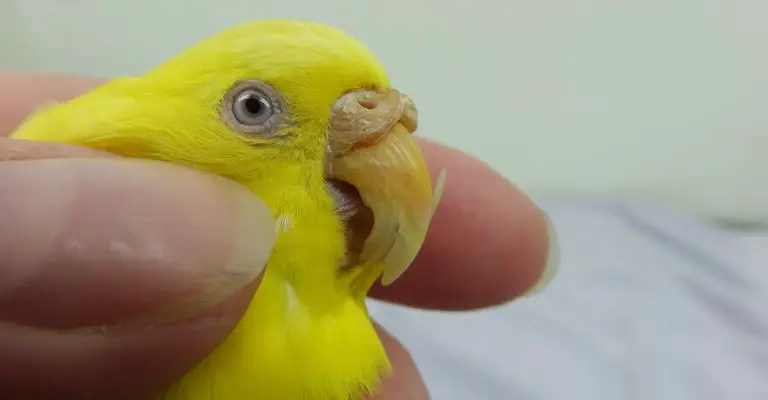
If your budgie has an overgrown beak, follow these methods to treat it:
Professional Trimming
If your budgie’s beak becomes overgrown, it is essential to seek professional help from an avian veterinarian or an experienced bird groomer.
These professionals have the knowledge and tools necessary to safely trim the beak and restore its proper shape. Regular trimming may be required until the underlying cause is addressed.
Nutritional Intervention
Ensuring your budgie’s diet is balanced and nutritious is crucial. Consult with an avian veterinarian to develop a suitable diet plan for your bird. Adding vitamin and mineral supplements may also be recommended to address any nutrient deficiencies.
Chew Toys and Perches
Provide your budgie with a variety of chew toys and perches made from safe materials such as untreated wood or bird-safe plastics. These toys encourage natural beak wear and help prevent overgrowth. Rotate toys regularly to maintain your budgie’s interest.
Addressing Underlying Health Issues
If the overgrown beak is due to an underlying health problem, such as liver disease, your avian veterinarian will develop a treatment plan accordingly. This may involve medications, dietary adjustments, or other therapeutic interventions.
How Is an Overgrown Beak Corrected?
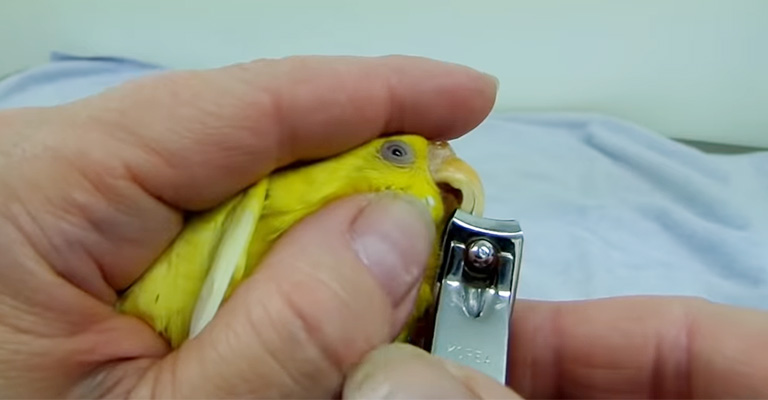
To correct an overgrown beak in a budgie, the underlying cause of the overgrowth needs to be identified and addressed. The specific approach to correcting the overgrown beak will depend on the cause and severity of the condition.
Here are some general steps that may be involved in correcting an overgrown budgie beak:
Veterinary Examination
Schedule an appointment with an avian veterinarian to have your budgie’s beak examined. The vet will assess the extent of the overgrowth and determine the underlying cause through a physical examination and potentially additional diagnostic tests.
Treat Underlying Health Issues
If the overgrown beak is due to an underlying health condition, such as liver disease or tumors, the veterinarian will develop a treatment plan to address the specific issue.
This may involve medication, dietary adjustments, or other therapeutic interventions to improve the budgie’s overall health.
Professional Beak Trimming
If the overgrown beak is primarily a result of abnormal growth without an underlying health issue, a professional beak trimming procedure may be performed.
An avian veterinarian or an experienced bird groomer will use specialized tools to carefully trim the overgrown portion of the beak and reshape it to a more appropriate length and alignment.
Nutritional Management
Ensure your budgie receives a well-balanced diet that includes a variety of fresh fruits, vegetables, pellets, and seeds. Nutritional deficiencies can contribute to beak overgrowth, so the veterinarian may recommend specific dietary adjustments or supplements to address any nutrient imbalances.
Environmental Enrichment
Provide your budgie with suitable chew toys and perches made from safe materials. Regular chewing and activity help naturally wear down the beak and prevent overgrowth.
Ensuring a stimulating environment with plenty of mental and physical stimulation can also contribute to overall beak health.
Ongoing Monitoring and Care
Regular follow-up appointments with the avian veterinarian are essential to monitoring the budgie’s beak growth and overall health. Additional beak trimmings may be required if the overgrowth persists or recurs.
The veterinarian will guide proper beak care and any necessary adjustments to the treatment plan.
Remember, the correction of an overgrown budgie beak should always be done under the guidance and supervision of a professional avian veterinarian.
They will provide tailored recommendations and treatments based on the specific needs of your budgie, ensuring the best possible outcome for their beak health.
How to Trim Budgie Overgrown Beak?
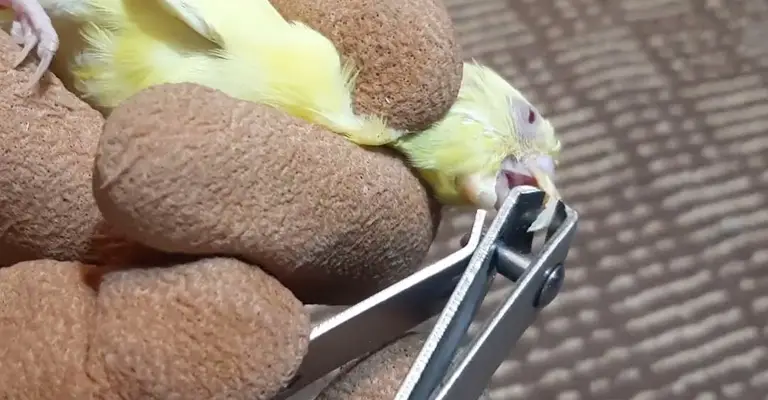
Trimming a budgie’s overgrown beak should be done by a professional, such as an avian veterinarian or an experienced bird groomer.
They have the knowledge, experience, and proper tools to safely trim the beak without causing injury to the bird. However, it can be helpful to understand the general process involved in trimming a budgie’s overgrown beak:
Seek Professional Help
Schedule an appointment with an avian veterinarian or a bird groomer who specializes in trimming bird beaks. They will assess the extent of the overgrowth and determine the best approach for trimming.
Sedation or Restraint
Depending on the budgie’s temperament and the severity of the overgrowth, the bird may need to be lightly sedated or gently restrained to ensure their safety and minimize stress during the procedure. This step is typically performed by the professional.
Beak Trimming Technique
The professional will use specialized tools, such as a beak trimmer or a Dremel tool with a sanding attachment, to carefully trim the overgrown portion of the beak. The goal is to reshape the beak to a more appropriate length and alignment.
Smoothing Rough Edges
After trimming, any rough or sharp edges on the beak are smoothed down using a file or a grinding tool. This helps prevent discomfort or injury to the budgie’s tongue or gums.
Post-Trimming Care
Once the beak is trimmed, the budgie may require some time to recover from the sedation or the stress of the procedure.
The professional may provide aftercare instructions, which may include dietary recommendations, monitoring for any signs of discomfort, and follow-up appointments if necessary.
How to Avoid Overgrown Beaks?
To help prevent overgrown beaks in budgies, consider the following tips:
Balanced Diet
Provide a well-balanced diet that includes a variety of fresh fruits, vegetables, pellets, and seeds. This ensures your budgie receives essential nutrients, including calcium and vitamin A, which are important for maintaining healthy beak growth.
Proper Chew Toys
Offer a variety of safe and appropriate chew toys made from bird-safe materials, such as untreated wood or bird-safe plastics. These toys provide opportunities for natural beak wear and help prevent overgrowth.
Monitor Beak Growth
Regularly observe your budgie’s beak for any signs of overgrowth, such as elongation or misalignment. Early detection allows for prompt intervention and prevents the beak from becoming severely overgrown.
Regular Veterinary Check-Ups
Schedule routine check-ups with an avian veterinarian to monitor your budgie’s overall health, including the condition of its beak.
The veterinarian can identify any potential issues and provide appropriate guidance and treatment if necessary.
Proper Environment
Create a stimulating environment for your budgie with plenty of opportunities for exercise, mental stimulation, and natural behaviors.
This includes providing perches of various sizes and textures, as well as access to safe outdoor exposure (if applicable), which can aid in beak maintenance.
Supervise Interactions
If you have multiple budgies, monitor their interactions to prevent fights or injuries that may lead to beak damage. Ensuring a harmonious social environment reduces the risk of beak-related problems.
Avoid Excessive Beak Trimming
While occasional professional beak trimming may be necessary, excessive trimming can disrupt the natural wear and growth balance of the beak.
Work closely with an avian veterinarian to determine the appropriate frequency and extent of beak trims, if needed.
Address Underlying Health Issues
Be proactive in addressing any underlying health conditions or diseases that may affect beak health.
Regular veterinary check-ups and early treatment of illnesses can help maintain the overall well-being of your budgie.
FAQs
Signs of an overgrown beak in budgies include elongation, curvature, or a misshapen appearance.
You may also observe difficulty in eating, excessive drooling, or a change in eating habits. If you notice any of these signs, it’s important to have your budgie examined by an avian veterinarian for a proper diagnosis.
Trimming a budgie’s beak requires skill and knowledge to avoid causing harm or pain to the bird.
It is recommended to seek professional help from an avian veterinarian or an experienced bird groomer who can safely trim the beak. They have the expertise and proper tools to perform the procedure without causing injury.
Beak overgrowth is unlikely to resolve on its own. It is important to address the underlying cause of the overgrowth, whether it’s nutritional imbalances, health issues, or other factors.
Seeking veterinary care and implementing appropriate treatment strategies are crucial for the well-being of your budgie.
To prevent beak overgrowth, provide your budgie with a balanced diet that includes a variety of fresh fruits, vegetables, pellets, and seeds.
Ensure they have access to suitable chew toys and perches made from safe materials. Regular veterinary check-ups and a stimulating environment can also help prevent beak-related problems.
Yes, beak overgrowth can sometimes indicate an underlying serious health issue, such as liver disease or tumors.
It is important to consult with an avian veterinarian to determine the cause of the overgrowth and to rule out any potential health concerns. Early detection and proper treatment can significantly improve the outcome for your budgie.
Bottom Line
That was all about budgie beak overgrown – causes and treatment. Budgie beak overgrowth can occur due to various factors, including nutritional imbalances, lack of appropriate chew toys, injuries, or underlying health conditions.
Prompt identification of the cause and appropriate treatment is crucial to prevent discomfort and potential complications for your feathered friend.
By providing a balanced diet, suitable chew toys, and regular veterinary care, you can help maintain your budgie’s beak health and overall well-being.